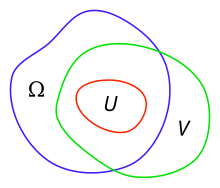Domain of holomorphy

In mathematics, in the theory of functions of several complex variables, a domain of holomorphy is a domain which is maximal in the sense that there exists a holomorphic function on this domain which cannot be extended to a bigger domain.
Formally, an open set in the n-dimensional complex space is called a domain of holomorphy if there do not exist non-empty open sets and where is connected, and such that for every holomorphic function on there exists a holomorphic function on with on
In the case, every open set is a domain of holomorphy: we can define a holomorphic function with zeros accumulating everywhere on the boundary of the domain, which must then be a natural boundary for a domain of definition of its reciprocal. For this is no longer true, as it follows from Hartogs' lemma.
Equivalent conditions[]
For a domain the following conditions are equivalent:
- is a domain of holomorphy
- is holomorphically convex
- is pseudoconvex
- is Levi convex - for every sequence of analytic compact surfaces such that for some set we have ( cannot be "touched from inside" by a sequence of analytic surfaces)
- has local Levi property - for every point there exist a neighbourhood of and holomorphic on such that cannot be extended to any neighbourhood of
Implications are standard results (for , see Oka's lemma). The main difficulty lies in proving , i.e. constructing a global holomorphic function which admits no extension from non-extendable functions defined only locally. This is called the Levi problem (after E. E. Levi) and was first solved by Kiyoshi Oka, and then by Lars H��rmander using methods from functional analysis and partial differential equations (a consequence of -problem).
Properties[]
- If are domains of holomorphy, then their intersection is also a domain of holomorphy.
- If is an ascending sequence of domains of holomorphy, then their union is also a domain of holomorphy (see Behnke-Stein theorem).
- If and are domains of holomorphy, then is a domain of holomorphy.
- The first Cousin problem is always solvable in a domain of holomorphy; this is also true, with additional topological assumptions, for the second Cousin problem.
See also[]
- Behnke–Stein theorem
- Levi pseudoconvex
- Stein manifold
References[]
- Steven G. Krantz. Function Theory of Several Complex Variables, AMS Chelsea Publishing, Providence, Rhode Island, 1992.
- Boris Vladimirovich Shabat, Introduction to Complex Analysis, AMS, 1992
This article incorporates material from Domain of holomorphy on PlanetMath, which is licensed under the Creative Commons Attribution/Share-Alike License.
- Several complex variables































